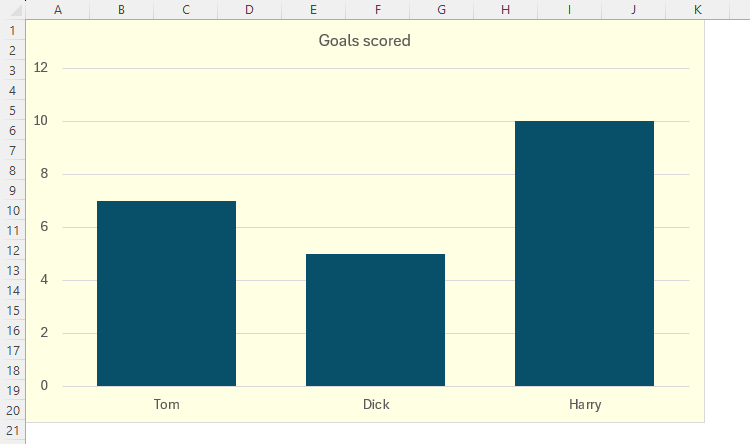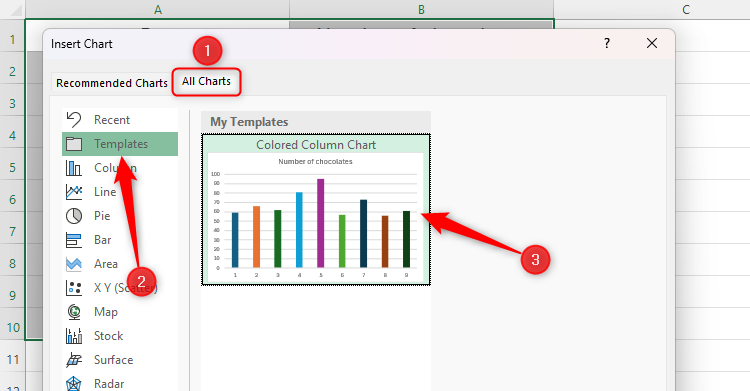The 6 Best Tips For Formatting Your Excel Charts
Excel chart formatting skills: improve data visualization effect
This article will share some practical tips to improve the visualization of Excel charts to help you create clearer and more attractive charts. Excel has built-in multiple chart styles, but for the best results, we recommend custom formatting.
1. Add a chart background
The charts need not be boring. Appropriate background can enhance the attractiveness of the chart and make the data clearer and easier to understand.
You can add pictures or colors as backgrounds. For example, using architectural pictures and sunset backgrounds makes the chart more visually impactful.

Even subtle color adjustments can make the chart stand out. The key is to have sufficient contrast between the background and the data points to ensure that the chart is easy to read.

How to operate: Double-click the edge of the chart and select the "Fill" menu in the "Format Chart" pane.

Select the fill type, such as "Solid Color Fill" to select the color and adjust the transparency; or select "Picture or Texture Fill" to insert the picture.


Remember, chart legibility is crucial. Avoid using too bright colors or complex textured backgrounds.
2. Adjust the minimum and maximum values of the coordinate axis
A clever adjustment of the axis range can make the chart data more efficient in making use of space, avoiding too dense data or unnecessary blanks.


How to operate: Double-click the axis and in the "Format Chart" pane, modify the minimum and maximum values in "Borders".



When data changes, the axis range needs to be readjusted to ensure that the chart accurately reflects the data. You can also adjust the Primary Unit and Secondary Units to control the intervals of the axis scales.
3. Reduce the spacing between bar charts or bar charts
The data point spacing in the Excel chart is expressed as percentages. The default spacing may be too large, affecting data comparison.


How to operate: Right-click the data point, select "Set Data Series Format", and adjust "Space Width" in the "Set Chart Format" pane.

4. Use visual elements in moderation
Avoid excessive complexity of charts. Not all Excel tools are required. Select the right element to achieve the best results.


You can use the chart element button (" sign) to select the desired element.

Or use the Reset to match style button to restore the default style.

5. Delete the worksheet grid line
Worksheet grid lines may affect the readability of the chart, especially if the chart background is transparent or translucent.

Uncheck "Grid Lines" in the View tab to make the chart clearer.

6. Save the chart design as a template
After the chart is finished formatting, save it as a template for reuse in the future.




The key to chart formatting is to optimize readability and maintain consistency. Apart from common pie charts and bar charts, don't forget to try other types of charts such as waterfall charts and sunburst charts.
The above is the detailed content of The 6 Best Tips For Formatting Your Excel Charts. For more information, please follow other related articles on the PHP Chinese website!

Hot AI Tools

Undresser.AI Undress
AI-powered app for creating realistic nude photos

AI Clothes Remover
Online AI tool for removing clothes from photos.

Undress AI Tool
Undress images for free

Clothoff.io
AI clothes remover

Video Face Swap
Swap faces in any video effortlessly with our completely free AI face swap tool!

Hot Article

Hot Tools

Notepad++7.3.1
Easy-to-use and free code editor

SublimeText3 Chinese version
Chinese version, very easy to use

Zend Studio 13.0.1
Powerful PHP integrated development environment

Dreamweaver CS6
Visual web development tools

SublimeText3 Mac version
God-level code editing software (SublimeText3)

Hot Topics
 1392
1392
 52
52
 36
36
 110
110
 5 Things You Can Do in Excel for the Web Today That You Couldn't 12 Months Ago
Mar 22, 2025 am 03:03 AM
5 Things You Can Do in Excel for the Web Today That You Couldn't 12 Months Ago
Mar 22, 2025 am 03:03 AM
Excel web version features enhancements to improve efficiency! While Excel desktop version is more powerful, the web version has also been significantly improved over the past year. This article will focus on five key improvements: Easily insert rows and columns: In Excel web, just hover over the row or column header and click the " " sign that appears to insert a new row or column. There is no need to use the confusing right-click menu "insert" function anymore. This method is faster, and newly inserted rows or columns inherit the format of adjacent cells. Export as CSV files: Excel now supports exporting worksheets as CSV files for easy data transfer and compatibility with other software. Click "File" > "Export"
 How to Create a Timeline Filter in Excel
Apr 03, 2025 am 03:51 AM
How to Create a Timeline Filter in Excel
Apr 03, 2025 am 03:51 AM
In Excel, using the timeline filter can display data by time period more efficiently, which is more convenient than using the filter button. The Timeline is a dynamic filtering option that allows you to quickly display data for a single date, month, quarter, or year. Step 1: Convert data to pivot table First, convert the original Excel data into a pivot table. Select any cell in the data table (formatted or not) and click PivotTable on the Insert tab of the ribbon. Related: How to Create Pivot Tables in Microsoft Excel Don't be intimidated by the pivot table! We will teach you basic skills that you can master in minutes. Related Articles In the dialog box, make sure the entire data range is selected (
 If You Don't Use Excel's Hidden Camera Tool, You're Missing a Trick
Mar 25, 2025 am 02:48 AM
If You Don't Use Excel's Hidden Camera Tool, You're Missing a Trick
Mar 25, 2025 am 02:48 AM
Quick Links Why Use the Camera Tool?
 You Need to Know What the Hash Sign Does in Excel Formulas
Apr 08, 2025 am 12:55 AM
You Need to Know What the Hash Sign Does in Excel Formulas
Apr 08, 2025 am 12:55 AM
Excel Overflow Range Operator (#) enables formulas to be automatically adjusted to accommodate changes in overflow range size. This feature is only available for Microsoft 365 Excel for Windows or Mac. Common functions such as UNIQUE, COUNTIF, and SORTBY can be used in conjunction with overflow range operators to generate dynamic sortable lists. The pound sign (#) in the Excel formula is also called the overflow range operator, which instructs the program to consider all results in the overflow range. Therefore, even if the overflow range increases or decreases, the formula containing # will automatically reflect this change. How to list and sort unique values in Microsoft Excel
 Use the PERCENTOF Function to Simplify Percentage Calculations in Excel
Mar 27, 2025 am 03:03 AM
Use the PERCENTOF Function to Simplify Percentage Calculations in Excel
Mar 27, 2025 am 03:03 AM
Excel's PERCENTOF function: Easily calculate the proportion of data subsets Excel's PERCENTOF function can quickly calculate the proportion of data subsets in the entire data set, avoiding the hassle of creating complex formulas. PERCENTOF function syntax The PERCENTOF function has two parameters: =PERCENTOF(a,b) in: a (required) is a subset of data that forms part of the entire data set; b (required) is the entire dataset. In other words, the PERCENTOF function calculates the percentage of the subset a to the total dataset b. Calculate the proportion of individual values using PERCENTOF The easiest way to use the PERCENTOF function is to calculate the single
 If You Don't Rename Tables in Excel, Today's the Day to Start
Apr 15, 2025 am 12:58 AM
If You Don't Rename Tables in Excel, Today's the Day to Start
Apr 15, 2025 am 12:58 AM
Quick link Why should tables be named in Excel How to name a table in Excel Excel table naming rules and techniques By default, tables in Excel are named Table1, Table2, Table3, and so on. However, you don't have to stick to these tags. In fact, it would be better if you don't! In this quick guide, I will explain why you should always rename tables in Excel and show you how to do this. Why should tables be named in Excel While it may take some time to develop the habit of naming tables in Excel (if you don't usually do this), the following reasons illustrate today
 How to Format a Spilled Array in Excel
Apr 10, 2025 pm 12:01 PM
How to Format a Spilled Array in Excel
Apr 10, 2025 pm 12:01 PM
Use formula conditional formatting to handle overflow arrays in Excel Direct formatting of overflow arrays in Excel can cause problems, especially when the data shape or size changes. Formula-based conditional formatting rules allow automatic formatting to be adjusted when data parameters change. Adding a dollar sign ($) before a column reference applies a rule to all rows in the data. In Excel, you can apply direct formatting to the values or background of a cell to make the spreadsheet easier to read. However, when an Excel formula returns a set of values (called overflow arrays), applying direct formatting will cause problems if the size or shape of the data changes. Suppose you have this spreadsheet with overflow results from the PIVOTBY formula,





